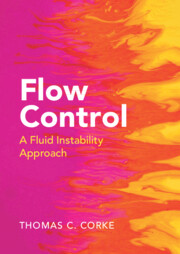Book contents
- Frontmatter
- Dedication
- Contents
- Preface
- 1 Introduction
- 2 Sensors and Actuators
- 3 Bluff Body Wakes
- 4 Separated Flows
- 5 Free Shear Layers and Jets
- 6 Two-Dimensional Laminar Boundary Layers
- 7 Three-Dimensional Laminar Boundary Layers
- 8 Turbulent Boundary Layers
- 9 Shock–Boundary-Layer Interaction
- 10 Flow Control by Design
- References
- Index
7 - Three-Dimensional Laminar Boundary Layers
Published online by Cambridge University Press: 04 April 2024
- Frontmatter
- Dedication
- Contents
- Preface
- 1 Introduction
- 2 Sensors and Actuators
- 3 Bluff Body Wakes
- 4 Separated Flows
- 5 Free Shear Layers and Jets
- 6 Two-Dimensional Laminar Boundary Layers
- 7 Three-Dimensional Laminar Boundary Layers
- 8 Turbulent Boundary Layers
- 9 Shock–Boundary-Layer Interaction
- 10 Flow Control by Design
- References
- Index
Summary
Chapter 7 deals with 3-D laminar boundary-layer instabilities and their control. It covers the full range of Mach numbers from incompressible to hypersonic. A practical example of a 3-D boundary layer is the flow over a swept wing, which is susceptible to four types of instabilities that can lead to turbulence onset. Of these, cross-flow instability is the most dominant and therefore the most studied 3-D boundary-layer instability mechanism. A fundamental understanding of the instability has led to methods of control that have been successfully demonstrated at incompressible to hypersonic Mach numbers. These and other methods of control are presented.
Keywords
Information
- Type
- Chapter
- Information
- Flow ControlA Fluid Instability Approach, pp. 278 - 334Publisher: Cambridge University PressPrint publication year: 2024
